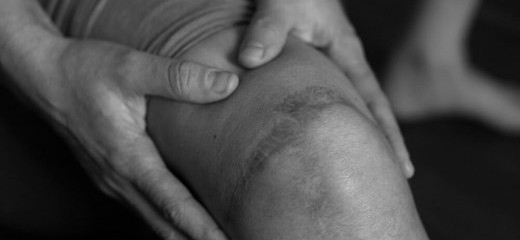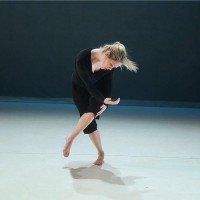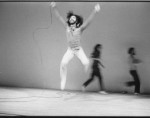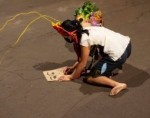
Single Thing, Infinite Folds
by Leslie Bush
Nicole Bindler* is already in motion when I arrive at The Whole Shebang. A red therapy lamp softly lights the angular space and Bindler casts shadows while she quietly shifts about. At one point, she briefly moves out of the studio and closes the door behind her. The audience sits in the red lit room with no performer to watch, and I begin to feel the strangely shaped room is gently folding me into it.
The Case for Invagination #2 is the second iteration of a performance born out of Bindler’s research on clitoral embodiment. Having not seen the prior version of the piece, I am unsure of what to expect. Invagination, after all, sounds unapproachably scientific. What I find, though, is a work of powerful vulnerability, humor, and deep embodiment of the ideas it presents. The piece challenges assumptions, both in the ideas behind the work, which begins with the simple idea of folding, and in its form. Bindler acknowledges a certain discomfort throughout, particularly during a moment of surprise audience participation when she asks all of the cisgender men to line up beside her and repeat phrases used to dismiss or undermine victims of sexual harassment and assault. Bindler mentions that this moment caused some controversy during the performance of the first version, but through all the uncomfortable parts, the piece challenges without alienating. It challenges in a confront systems of power directly while speaking through a talking knee scar kind of way. And also, acknowledge your own role in power dynamics by speaking through your belly button. The strange juxtapositions break some of the tension.
The moments where Bindler moves through the space are meditative. She subtly rotates and spirals her spine and joints, she pauses to listen, to feel, to drop into her investigation more. She shifts her weight through her pelvis deep into the floor. She rests on a pillar and in a tight corner. Later, she asks the audience to embody the concept of invagination with our arms and hands; she tells us to imagine the whites of an egg gently sliding to support our outstretched limbs. Instantly I feel the folding and swirling I saw in her body a half hour earlier. She briefly revisits the improvisation, perhaps with a little more momentum, at the end of the performance. Nadia Botello’s sound score “Saint Shë: Ska jag berätta en hemlighet?” accompanies her dancing. Like the performance, the score remains unsettled, with broad changes every few minutes from steady electronic beats to operatic voices over ambient sounds. It subtly supports Bindler’s movement without overpowering it.
Bindler uses three of her own bodily invaginations as narrators; the aforementioned belly button and knee scar, and an existentially anxious neck scar. These three characters reveal their own stories to us in a darkened room. Shining a small flashlight onto her body, Bindler moves the skin of her belly, knee, and neck around in pantomimed talking motions, and gives distinct voice inflections to bring the characters to life. The belly button character, especially, seems determined that the audience understand how important the idea of invagination is—to our biology, but also to things like language and consent culture—and plays a series of YouTube videos about invagination for us. This is a moment that could have disrupted the introspective tone of the pre-show improvisation, but is made light and a little funny through the belly button’s dialogue. Later, her neck scar tells us they are particularly worried about disappearing. An audience member with an appendectomy scar comes onstage to comfort the neck scar, and Bindler, awkwardly but tenderly, bends down to nuzzle her neck into the other person’s stomach, the neck scar’s version of a hug.
For Bindler, invaginations are embodied memories—of birth, violence, sickness, warmth, and tenderness. The piece manages to explore this without feeling self-indulgent and without gendering the ideas behind invagination. Throughout the performance Bindler champions invagination as a way to experience the body as an infinitely folding thing, continuously interacting with itself and its surroundings. Cleverly, the work itself also feels like an unfolding. In this way, she succeeds in making her case.
*Nicole Bindler is a former thINKingDANCE writer
The Case for Invagination #2, Nicole Bindler, The Whole Shebang, October 26.
By Leslie Bush
November 2, 2019







